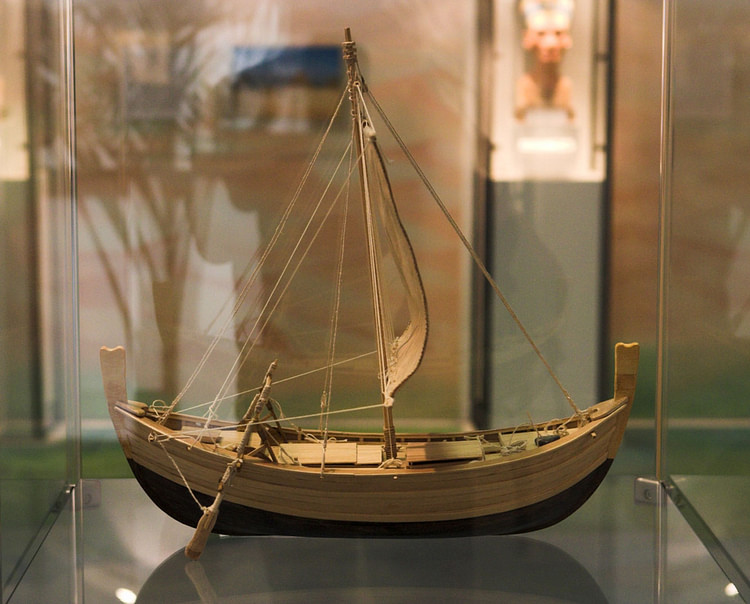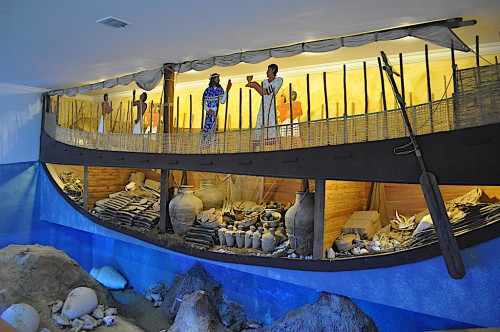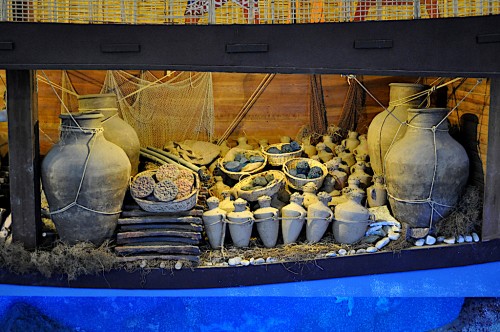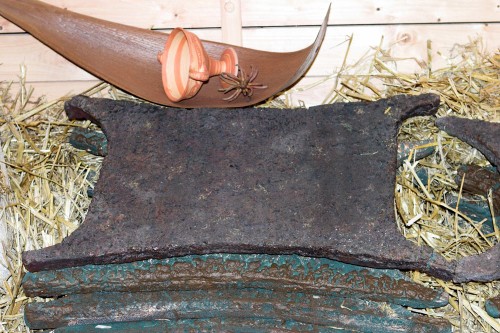Tantalus › Uluburun Shipwreck » Ancient origins
Articles and Definitions › Contents
- Tantalus › Who Was
- Uluburun Shipwreck › Antique Origins
Ancient civilizations › Historical and archaeological sites
Tantalus › Who Was
Definition and Origins

Tantalus is a figure from Greek mythology who was the rich but wicked king of Sipylus. For attempting to serve his own son at a feast with the gods, he was punished by Zeus to forever go thirsty and hungry in Hades despite being stood in a pool of water and almost within reach of a fruit tree. His terrible punishment was set as a warning for humanity not to cross the line between mortals and gods.
GENEALOGY
Tantalus was the legendary king of Sipylus, a kingdom which bordered Lydia and Phrygia. Tantalus' father was Zeus and his mother Pluto, daughter of Cronus and Rhea. He was famed for his great wealth, much like those other Asian kings Croesusand Midas. So much so, the king gave rise to the Greek expression, 'the talents of Tantalus.' His wife differs in various accounts – Euryanassa or Eurythemista, both daughters of river gods, or Clytie, daughter of Aphidamantess, or Dione, one of the Pleiades. He was the father of Pelops, the charioteer hero of Olympia, and Niobe, who foolishly boasted her large number of children showed she was superior to Leto, and so her nine daughters and nine sons were killed by the goddess Artemiswith the help of Apollo.
DINNER WITH THE GODS
The first generation of mortals was given the privilege of dining with the gods on Mt. Olympus, but Tantalus misbehaved spectacularly and made his host Zeus positively livid with outrage. There are three versions of Tantalus' mischief. The first is that he gossiped with his fellow mortals as to what the gods were cooking up with their divine plans for humanity. The second version has Tantalus stealing some of the divine nectar and ambrosia served at the dinner and giving it out to mere mortals down below. These two sins were bad enough and threatened the balance of order between gods and humanity, but the third version, the most popular one, tells of an even more outrageous deed.
TANTALUS RECEIVED ONE OF THOSE DELICIOUS PUNISHMENTS THAT ZEUS OCCASIONALLY DISHED OUT TO THE PARTICULARLY WICKED.
Wishing to test if the gods really did know everything and could tell what they were eating even if it was forbidden food, Tantalus killed, diced, and cooked up in a stew his own son Pelops and planned to serve him to all the gods at dinner. The plan fell flat when the Olympians immediately recognised that something was amiss, all that is except one. Demeter, upset at still not having found her lost daughter Persephone, absent-mindedly ate a chunk of Pelops' shoulder. For this reason, when Tantalus' wickedness was revealed and the gods decided to put Pelops back together and make him live again, the young man had to have a prosthetic shoulder made from ivory.
ZEUS' PUNISHMENT
For his audacity, Tantalus first had his kingdom and dynasty cursed and then, in the afterlife, he was to receive one of those delicious punishments that Zeus occasionally dished out to the particularly wicked amongst the mortals. Sisyphus had to forever roll a stone up a hill each day, Ixion was tied to a flaming wheel that never stopped spinning, and Tantalus, completing the most unfortunate trio in Hades, was made to stand in a pool of water but never able to drink from it and quench his insatiable thirst as it drains whenever he bends down to drink. As an added frustration, he was positioned below a tree but can never quite grasp the succulent fruit that hangs from its boughs. He is seen in this condition by the wandering Odysseus down in Hades in Homer 's Odyssey. The hero describes the scene, thus:
I also saw the awful agonies that Tantalus has to bear. The old man was standing in a pool of water which nearly reached his chin, and his thirst drove him to unceasing efforts; but he could never reach the water to drink it. For whenever he stooped in his eagerness to drink, it disappeared. The pool was swallowed up, and all there was at his feet was the dark earth, which some mysterious power had drained dry. Trees spread their foliage high over the pool and dangled fruits above his head – pear-trees and pomegranates, apple-trees with their glossy burden, sweet figs and luxuriant olives. But whenever the old man made to grasp them in his hands, the wind would toss them up towards the shadowy clouds. ( Odyssey, 11:582-593)
 SISYPHUS, IXION AND TANTALUS
SISYPHUS, IXION AND TANTALUS

MT. SIPYLUS & THE DESTRUCTION OF TANTALIS
Some authors give a third twist and have a rock precariously balanced overhead in perpetual danger of falling and squashing the villain instantly. This explains why Tantalus is pointing to a cliff in a scene from a 4th-century BCE red-figure vase from Apulia. This scene may also relate to one version of the Tantalus myth where the king kept the fabulous golden mastiff made by Hephaistos that had guarded Zeus when he was in the cave on Crete as a youngster. Tantalus, a receiver of stolen goods from the thief Pandareus, had refused to give up the idol until Hermes intervened. Zeus, on learning of the crime, had the king crushed under a cliff on Mt. Sipylus, the source of the kingdom's great mineral wealth.
It is interesting that the ancient authors Strabo and Pausanias both claimed the city of Tantalis was destroyed in violent earthquakes which struck throughout Lydia and Ionia. Mt. Sipylus collapsed, marshes became flooded, and Tantalis was eventually submerged beneath a lake. Could this be the geophysical explanation for the punishment of Tantalus? Whatever the reason for the myth and Tantalus' ultimate punishment, from which derives the verb tantalise, the story was a terrible reminder for all mortals lest they be tempted into immoral and impious behaviour.
Uluburun Shipwreck › Antique Origins
Definition and Origins

The Uluburun shipwreck is a Bronze Age vessel discovered lying off the coast of Kas, Turkey. The ship, probably originally from Phoenicia / Canaan, dates to between 1330 and 1300 BCE and was carrying a full cargo of trade goods, perhaps from a port in the southern part of ancient Lycia and likely on its way to the Greek mainland. Marine archaeologists excavated the site over eleven seasons beginning in 1984 CE and have accumulated over 17 tons of artefacts - a treasure trove of goods and information on the trade and cultural interaction across the ancient Bronze Age Mediterranean.
DATING
Radiocarbon dating techniques and the presence of identifiable pottery types place the date of the wreck as sometime in the late 14th century BCE, probably between 1330 and 1300 BCE. Unfortunately, much of the actual ship has not survived, but portions of the keel and planking and the total quantity of goods found in it have helped create a reconstruction of the ship's size. It is estimated the Uluburun wreck was once around 15 metres in length, 5 metres wide and capable of carrying up to 20 tons of cargo. The hull and keel were made from Lebanese cedar with fixtures and fastenings in oak.
CARGO
Thanks to the depth of the wreck (44-61 metres), it had not been plundered prior to its archaeological excavation by the Institute of Nautical Archaeology of Texas A&M University. A consequence of this depth, though, was that divers were limited in the time they could spend on the wreck, resulting in over 22,400 dives to bring up over 17 tons of artefacts. An additional difficulty was the disintegration of the wreck over a steep slope which spread the cargo over some 250 square metres.

Cargo Reconstruction, Uluburun Shipwreck
The main cargo of the ship was raw materials. The largest item was copper ingots, 348 of them, totalling 10 tons in weight.These took the form of 'oxhide' and circular buns, which refers to the shape they had, forms common in the Bronze Age Mediterranean. Lead isotope analysis revealed the ingots were pure copper and from Cyprus. The ingots were placed in four rows along the length of the ship's hold in a herringbone arrangement to minimise their movement while at sea.
The next biggest load was 120 pure tin ingots (also in 'oxhide' or bun shape) weighing over a ton in total. Analysis showed that these ingots were originally from mines in the Taurus mountains in Turkey and a source in Afghanistan or nearby; although the fact many of them were cut into four pieces suggests they were not taken directly from the mines but had already been traded elsewhere. There were around 150 Canaanite jars of terebinth resin, the largest such find ever. Analysis of pollen within the resin indicates it came from Israel.
MISCELLANEOUS GOODS ON THE SHIP INCLUDE 24 EBONY LOGS & IVORY IN THE FORM OF A SINGLE ELEPHANT TUSK & 14 HIPPOPOTAMUS TEETH.
In nine Cypriot pithoi (large storage jars) there were carefully stored Cypriot pottery wares, olive oil or pomegranates. There was a quantity of glass disk ingots, perhaps over 175, weighing a total of 350 kilos but most were eroded. The glass was in four colours: dark blue, turquoise, purple, and yellow, no doubt, destined to be cut into beads or used as inlay in jewellery as a cheaper imitation of the more precious materials lapis lazuli, turquoise, amethyst, and amber respectively. There were also some 70,000 beads on board in glass and faience. Finally, regarding heavy materials, there was around one ton of cobble ballast in the ship.
Miscellaneous goods on the ship, of which there were many, include 24 ebony logs, ivory in the form of a single elephant tusk and 14 hippopotamus teeth, and manufactured ivory goods. There are many pieces of jewellery made from gold, silver, bronze, tin, faience, and glass. In the same materials, there are also figurines, vessels, and weapons. Wooden items have not survived well but there are remains of high-quality boxes. More exotic items on board include Baltic amber, an Italian sword, three ostrich eggshell vases, and cylinder seals from Mesopotamia. Perishable goods, besides those already mentioned, known to have been carried on the ship included spices (cumin, sumac), herbs (coriander, sage), condiments (safflower), olives, almonds, grapes, figs, grain, murex shells, and orpiment, a yellow mineral used as a dye.

Cargo, Uluburun Shipwreck
Taken as a whole, the cargo of the Uluburun was clearly of very high value and destined for use by the elite of whichever society it ended up in. Indeed, the type of goods on board closely resemble other known gift inventories exchanged between rulers in Egypt and western Asia.
It is also to be remembered that some of the artefacts from the wreck, for example the manufactured ivories and jewellery items, may well have belonged to the crew of the Uluburun and were not destined for trade. In addition, it is no surprise that many excavated artefacts relate to the actual running of the ship such as galley wares, lamps, fishing tools, and scrap gold and silver jewellery to be used as payments. The discovery of four balances and their accompanying weights would suggest there were four Phoenician/Canaanite merchants on board. That one was senior, perhaps even the captain, is hinted at by the presence of one superior set of weights being in the form of animals and a single Phoenician sword with an ivory and ebony inlay handle. Mycenaean goods, notably seals and double axes, as wells as pairs of personal effects from mainland Greecesuggest that at least two other people on board were Mycenaean.
SAILING ROUTE
The construction techniques used in the ship, analysis of the pottery wares likely used by the crew, and the presence of 24 stone anchors of a Syrio-Palestinian or Cypriot type would strongly suggest the ship's home port was in the Levant, possibly Tell Abu Hawam (modern Haifa, Israel). This port was particularly active in trade during the period in question, and finds at the site are strikingly similar to those in the Uluburun wreck.
Scholars generally agree that the ship was travelling west prior to its sinking and so had probably just left a port in Lycia (modern Turkey). The fact that the pottery was mostly of a Cypriot kind, and there were only very few Aegean wares, is taken as strong evidence that the Uluburun was leaving Lycia when it was wrecked and not arriving. That the ship may have left a southern port which was servicing Ugarit is suggested by chemical analysis of the clay used in much of the cargo pottery on board and the similarity of it to wares found in storerooms at Minet-el Beida.

Copper
Still, it should be remembered that any certain statements about the ship's ports of call before or after it met disaster based solely on its cargo must be countered with the fact that in the Bronze Age Mediterranean goods from Cyprus, Egypt, Anatolia, and the Levant were widely traded to and fro, including stockpiling and resale at cosmopolitan emporiums such as on Cyprus.However, the fact that much of the Cypriot pottery on board is of different types would suggest that the ship had not sailed directly from Cyprus, where it could have picked up a more homogenous cargo direct from the manufacturing centre, but had just left a port where goods from various sources were stockpiled.
The ultimate destination of the Uluburun ship may well have been mainland Greece if there was indeed two Mycenaeans of an elite status on board, a typical feature of ancient trade where individuals followed a cargo to ensure its arrival as promised or served as messengers from and to the royal household sending the shipment. The cargo was a significant one for the period and would have enriched the recipient and been a significant source of prestige if the Uluburun ship was a diplomatic embassy with gifts from one ruler to another. One can only speculate what were the financial and political consequences of such a valuable shipment not reaching its final destination.
The cause of the shipwreck will probably never be known, but as the wreck lies close to a rocky promontory, it would seem reasonable to suppose that unexpected winds may have driven the ship onto these rocks and so caused it to sink. The presence of weapons on boards reminds that maritime trade was threatened by piracy, but it seems this vessel was dealt its fate by nature's hand. It was a tragedy for the ship's crew and the wealthy merchants who had paid for her cargo, but archaeologists and historians have thus been presented with a fascinating insight into ancient regional interactions. The Uluburun wreck is one of those rarest of occurrences in archaeology of an undisturbed time capsule of the past, providing, in this case, a unique window into Bronze age maritime trade and those who pursued it.
LICENSE:
Article based on information obtained from these sources:with permission from the Website Ancient History Encyclopedia
Content is available under License Creative Commons: Attribution-NonCommercial-ShareAlike 3.0 Unported. CC-BY-NC-SA License